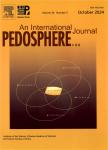Comparison of Urea-Derived N_2O Emission from Soil and Soil-Plant System
Comparison of Urea-Derived N_2O Emission from Soil and Soil-Plant System作者机构:LaboratoryofEcologicalProcessofTraceSubstanceinTerrestrialEcosystemInstituteofAppliedEcologyTheChneseAcademyofSciencesShenyang110015China FacultyofAgriculturalandAppliedBiol
出 版 物:《Pedosphere》 (土壤圈(英文版))
年 卷 期:2000年第10卷第3期
页 面:207-212页
核心收录:
学科分类:090101[农学-作物栽培学与耕作学] 09[农学] 0901[农学-作物学]
基 金:the National Natural Science Foundation of China (No. 39730110) and the Ministryof Foreign Affairs Belgium (ABOS) through "VL
主 题:N2O emission soil soil-plant system ure
摘 要:A pot experiment with a sandy loam soil and spring wheat as test crop was conducted to compare the N2O emission from soil system with plant cut off and from soil-plant system with plant kept. The results showed that after urea fertilizer applied, the N2O emission from soil and soil-wheat system decreased exponentially with time, and its total amount was 0.34%~0.63% and 0.33%~0.58% of applied urea-N respectively, no significant difference being found between these two systems. The N2O emission had a very significant negative relationship (P = 0.01) with the biomass of wheat plant. A combined application of urease inhibitor hydroquinone and nitrification inhibitor dicyandiamide could reduce the N2O emission by 50%~83% and 46%~74%, respectivelyl from soil and soil-wheat system. The N2O was mainly produced and emitted from soil, and the soil biochemical regulation, i.e., applying related inhibitors into soil could effectively diminish the urea derived N2O emission.



